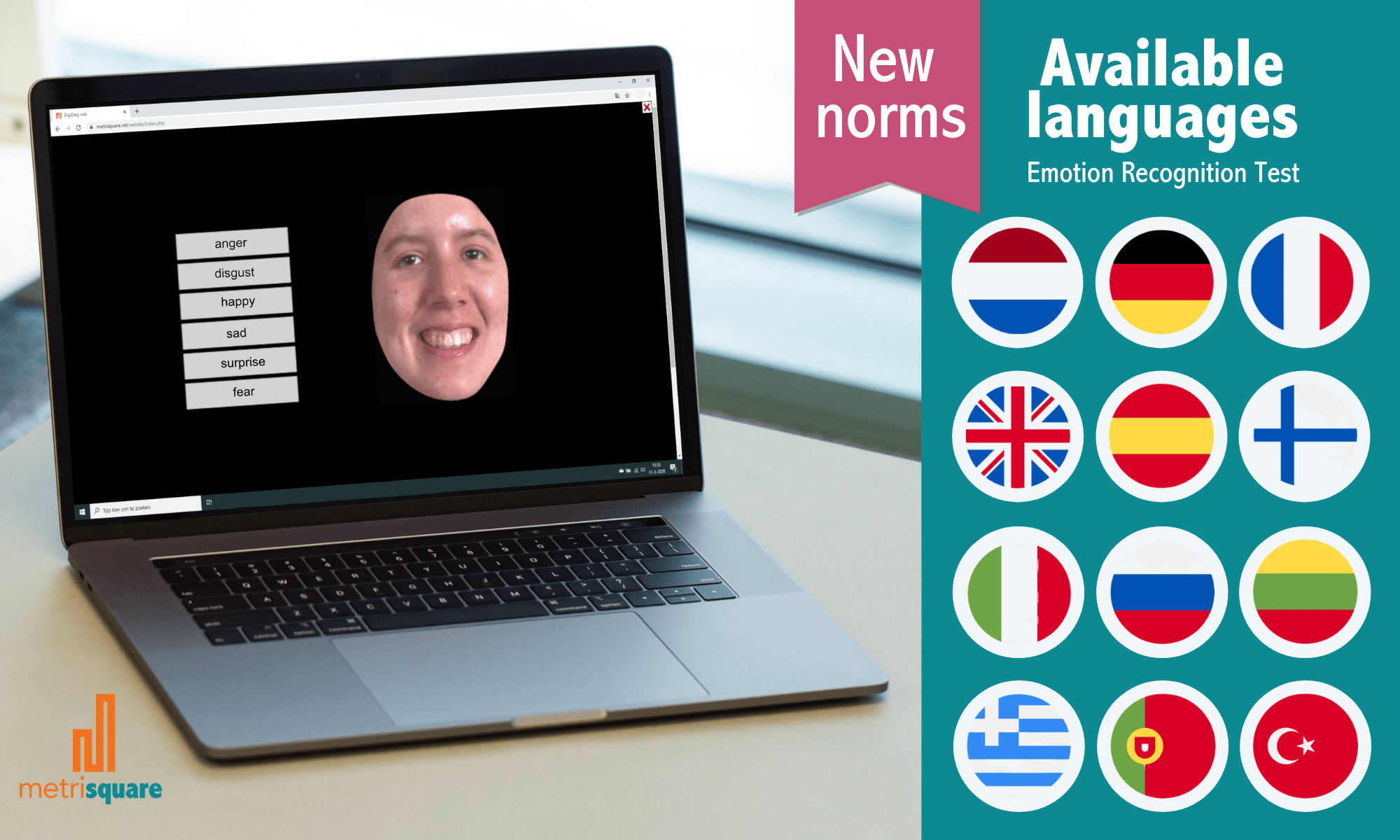ERT Emotionserkennungstest
DigiDiag
Assessment of perception of morphed facial expressions using the Emotion Recognition Task (ERT): Normative data from healthy participants aged 8-75
Kessels, R.P.C., Montagne, B., Hendriks, A.W., Perrett, D.I, & De Haan, E.H.F. (2014). Journal of Neuropsychology, 8, 75-93.
https://bpspsychub.onlinelibrary.wiley.com/doi/10.1111/jnp.12009
De Emotion Recognition Task (ERT): Een test om de perceptie van emotionele gezichtsuitdrukkingen te meten
Kessels, R.P.C. & Montagne, B. (2017). Tijdschrift voor Neuropsychologie, 2, 181 – 194. Amsterdam: Boom Testuitgevers
https://www.tvnp.nl/inhoud/tijdschrift_artikel/NP-11-2-06/De-Emotion-Recognition-Task-ERT-Een-test-om-de-perceptie-van-emotionele-gezichtsuitdrukkingen-te-meten
![ERT authors [Barbara Montagne, Roy Kessels, Edward de Haan and David Perrett] group photo of the ERT authors; Barbara Montagne, Roy Kessels, Edward de Haan and David Perrett](https://metrisquare.de/wp-content/uploads/2023/04/final-ERT-authors-Barbara-Montagne-Roy-Kessels-Edward-de-Haan-and-David-Perrett.png)

Emotionserkennungstest auf der Grundlage wissenschaftlicher Forschung
Bei der Emotionserkennungsaufgabe (ERT) wechseln die Bilder von Gesichtern allmählich von neutral zu einer bestimmten Emotion. Der Klient wird aufgefordert, die Emotion zu erkennen. Der Test wurde von Barbara Montagne, Roy Kessels, David Perrett und Edward de Haan entwickelt. Die Autoren haben den Test auf der Metrisquare-Plattform DigiDiag veröffentlicht; er ist kostenlos, wenn er wissenschaftlich genutzt wird.
Auf Regression basierende Normen liegen aus einer Stichprobe von 418 gesunden Teilnehmern aus den Niederlanden, Irland, Deutschland und Australien im Alter von 8-88 Jahren vor. Neue Normen sind seit 2020 verfügbar (Aktualisierte normative Daten 2020 18-88 (n=255)).
Die Daten der einzelnen Teilnehmer werden zu Forschungszwecken auf der Ebene der einzelnen Studien gespeichert. Es wird auch ein aggregierter PDF-Bericht pro Person erstellt, der die Leistung der Person als Perzentil für jede Emotion sowie die Gesamtpunktzahl anzeigt. Der ERT ist in Niederländisch, Englisch, Deutsch, Französisch, Spanisch, Italienisch, Portugiesisch, Türkisch, Finnisch, Litauisch und Russisch verfügbar. Eine andere Sprache kann einfach über den Test ausgewählt werden. Möchten Sie den Test in einer anderen Sprache erhalten? Dann kontaktieren Sie uns bitte.
Der ERT ist ein kostenloser Test, Sie zahlen nur für die Plattform und die Verbindungsgebühr. Wenn Sie sich für die klinische Version entscheiden, können Sie unsere Dienstleistungen in Anspruch nehmen, die sicherstellen, dass das Gerät sicher für klinische Zwecke in einer Gesundheitseinrichtung verwendet werden kann.
ERT for Research on Dementia
Metrisquare has partnered with the Centre for Healthy Brain Ageing (CHeBA) at University of New South Wales Sydney in Australia to deliver an online tool to assess social cognition.
Even though social cognition is often affected in dementia, it is less well understood than memory and executive function. There are expected age-related changes in social cognition in healthy and cognitively normal older adults but the extent to which this varies is not clear.
Work at CHeBA seeks to ascertain what can be considered normative social cognitive functioning in older adults, what changes are attributable to normal age-related changes, and if early changes in social cognitive function can serve as a marker of cognitive decline and predict future onset of dementia. By assessing social cognition in older Australian twins, researchers at CHeBA will also examine the extent to which social cognition and changes in social cognition are determined by genetics and our environment.
Social perception, which is the gathering and detection of social cues from one’s environment to assess a situation, is a subdomain of social cognition. The most salient example of this is emotion recognition, particularly through facial expressions and tone of voice.
While dementia is associated with outright impairments in correctly identifying certain facial expressions of emotions, it is likely that this impairment has a gradual onset, and that milder forms of cognitive impairment is associated with slight impairments in recognizing emotions at an incremental level.
For this reason, CHeBA decided to use the Emotion Recognition Task (ERT) hosted on the Metrisquare platform to quantify this skill. The ERT assesses participants on their accuracy in identifying the six basic emotions (anger, fear, disgust, happiness, sadness, surprise) at various intensities (20%, 40%, 60%, 80%, 100%) and allows the researchers to better map out more subtle differences and changes in emotion recognition ability. The ERT has been validated in numerous other clinical groups, including autism spectrum disorders, frontotemporal dementia, and Alzheimer’s disease.
CHeBA’s vision is to achieve, through research, healthier brain ageing and better clinical care of age-related brain diseases. Metrisquare is proud to partner with them in this endeavour.

Text written and approved by: (left) Vibeke Catts, Study Coordinator Older Australian Twins Study (OATS) and (right) Russell Chander, Scientia PhD Scholar, at CHeBA, UNSW Sydney.

